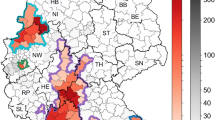Abstract
We describe an early warning indicator for monitoring infectious diseases. The approach is illustrated with data from a major sheep pox epidemic, which occurred in the Evros prefecture of Greece, from August 2013 until the end of 2014. We present the epidemic data and identify factors affecting this major epidemic using a suitable methodological framework for the sequential analysis of such outbreaks. Environmental conditions and seasonality affect the spread of the epidemic: autumn seems to enhance disease occurrence and higher average temperatures facilitate disease spread. The on-line prediction of the disease potential is investigated through an early warning system that is based on the probability of the disease going extinct. The temporal stability of this indicator is extensively explored.




Similar content being viewed by others
References
Bertuzzo E, Finger F, Mari L et al (2014) On the probability of extinction of the Haiti cholera epidemic. Stoch Environ Res Risk Assess. doi:10.1007/s00477-014-0906-3
Bhanuprakash V, Moorthy AR, Krishnappa G, Srinivasa GR, Indrani BK (2005) An epidemiological study of sheep pox infection in Karnataka State, India. Rev Sci Tech OIE 24(3):909–920
Bové DS, Held L (2011) Hyper-g priors for generalized linear models. Bayesian Anal 6(3):387–410
Branscum AJ, Perez AM, Johnson WO, Thurmond MC (2008) Bayesian spatiotemporal analysis of foot-and-mouth disease data from the Republic of Turkey. Epidemiol Infect 136:833–842
Chhetri BK, Perez AM, Thurmond MC (2010) Factors associated with spatial clustering of foot-and-mouth disease in Nepal. Trop Anim Health Prod 42:1441–1449
Chis-Ster IC, Ferguson NM (2007) Transmission parameters of the 2001 foot and mouth epidemic in Great Britain. PLoS One 6:e502
Choi YK, Johnson WO, Jones G, Perez A, Thurmond MC (2012) Modelling and predicting temporal frequency of foot-and-mouth disease cases in countries with endemic foot-and-mouth disease. J R Stat Soc A Stat 175(2):619–636
Deardon R, Brooks SP, Grenfell BT, Keeling MJ, Tildesley MJ, Savill NJ, Shaw DJ, Woolhouse MEJ (2010) Inference for individual level models of infectious diseases in large populations. Stat Sin 20(1):239–261
DEFRA (2013) Sheep pox goat pox in Bulgaria. Preliminary outbreak assessment, 2013. http://www.defra.gov.uk/animal-diseases/files/poa-sheep-pox-bulgaria.pdf. Accessed 30 Sept 2013
European Commission (2013) Sheep pox and goat pox in Greece (Evros prefecture). Presentation to the standing committee on the food chain and animal health 2013. (SCoFCAH) http://ec.europa.eu/food/committees/regulatory/scfcah/animal_health/presentations/1011092013_sgp_greece_en.pdf. Accessed 1 Oct 2013
Farrington CP, Kanaan MN, Gay NJ (2003) Branching process models for surveillance of infectious diseases controlled by mass vaccination. Biostatistics 4(2):279–295
Garner MG, Sawarkar SD, Brett EK, Edwards JR, Kulkami VB, Boyle DB, Singh SN (2000) The extent and impact of sheep pox and goat pox in the state of Maharashtra, India. Trop Anim Health Prod 32(4):205–223
George EI, McCulloch RE (1993) Variable selection via Gibbs sampling. J Am Stat Assoc 88:881–889
Hung H, Wang Y, Yen AM et al (2014) Stochastic model for hepatitis B virus infection through maternal (vertical) and environmental (horizontal) transmission with applications to basic reproductive number estimation and economic appraisal of preventive strategies. Stoch Environ Res Risk Assess 28:611–625
Keeling MJ, Woolhouse ME, Shaw DJ, Matthews L, Chase-Topping M, Haydon DT, Cornell SJ, Kappey J, Wilesmith J, Grenfell BT (2001) Dynamics of the 2001 UK foot and mouth epidemic: stochastic dispersal in a heterogeneous landscape. Science 294:813–817
Kuo L, Mallick B (1998) Variable selection for regression models. Sankhya Ser B 60:65–81
Liang F, Paulo R, Molina G, Clyde MA, Berger JO (2008) Mixtures of g priors for Bayesian variable selection. J Am Stat Assoc 103(481):410–423
Lunn DJ, Thomas A, Best N, Spiegelhalter D (2000) WinBUGS—a Bayesian modelling framework: concepts, structure, and extensibility. Stat Comput 10:325–337
Malesios C, Demiris N, Abas Z, Dadousis K, Koutroumanidis T (2014a) Modeling sheep pox disease from the 1994–1998 epidemic in Evros prefecture, Greece. Spat Spatiotemporal Epidemiol 11:1–10
Malesios C, Demiris N, Ntzoufras I, Kalogeropoulos K (2014) Bayesian modelling with applications to sheep pox epidemic data. Revision submitted to the J R Stat Soc A Stat. arXiv:1403.1783 [stat.AP]
Moustakas A, Evans MR (2016) Regional and temporal characteristics of bovine tuberculosis of cattle in Great Britain. Stoch Environ Res Risk Assess 30:989–1003
Mukasa-Mugerwa E, Lahlou-Kassi A, Anindo D, Rege JEO, Tembely S, Tibbo M, Baker RL (2000) Between and within breed variation in lamb survival and the risk factors associated with major causes of mortality in indigenous Horro and Menz sheep in Ethiopia. Small Rumin Res 37(1):1–12
R Development Core Team (2008) R: a language and environment for statistical computing. R Foundation for Statistical Computing, Vienna. ISBN 3-900051-07-0
Scott JG, Berger JO (2010) Bayes and empirical-Bayes multiplicity adjustment in the variable-selection problem. Ann Stat 38:2587–2619
Sturtz S, Ligges U, Gelman A (2005) R2WinBUGS: a package for running WinBUGS from R. J Stat Softw 12(3):1–16
Szmaragd C, Wilson AJ, Carpenter S, Wood JLN, Mellor PS, Gubbins S (2009) A modeling framework to describe the transmission of bluetongue virus within and between farms in Great Britain. PLoS One 4(11):e7741
World Organisation of Animal Health OIE (2002) Data on animal disease—compilation of data by disease—sheep pox and goat pox. (List A) Disease card, 2002. http://www.oie.int/animal-health-in-the-world/technical-disease-cards/. Accessed June 2012
World Organization for Animal Health OIE (2014) Technical disease cards: sheep pox and goat pox
Yeruham I, Yadin H, Van Ham M, Bumbarov V, Soham A, Perl S (2007) Economic and epidemiological aspects of an outbreak of sheeppox in a dairy sheep flock. Vet Rec 160(7):236
Author information
Authors and Affiliations
Corresponding author
Electronic supplementary material
Below is the link to the electronic supplementary material.
Rights and permissions
About this article
Cite this article
Malesios, C., Kostoulas, P., Dadousis, K. et al. An early warning indicator for monitoring infectious animal diseases and its application in the case of a sheep pox epidemic. Stoch Environ Res Risk Assess 31, 329–337 (2017). https://doi.org/10.1007/s00477-016-1316-5
Published:
Issue Date:
DOI: https://doi.org/10.1007/s00477-016-1316-5




